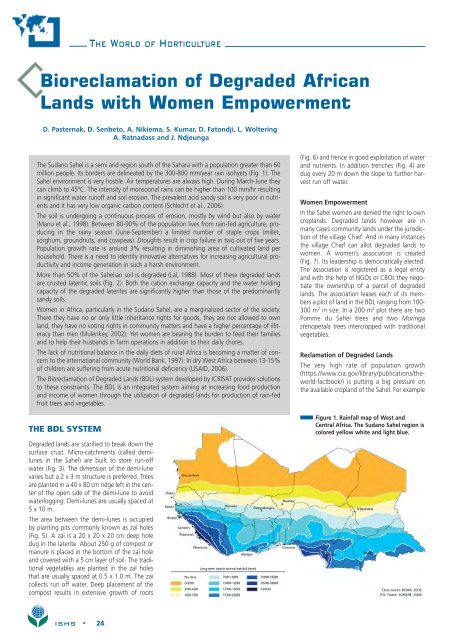Chronica Horticulturae volume 49 number 2 ... - Acta Horticulturae
Chronica Horticulturae volume 49 number 2 ... - Acta Horticulturae
Chronica Horticulturae volume 49 number 2 ... - Acta Horticulturae
Create successful ePaper yourself
Turn your PDF publications into a flip-book with our unique Google optimized e-Paper software.
THE WORLD OF HORTICULTURE<br />
Bioreclamation of Degraded African<br />
Lands with Women Empowerment<br />
D. Pasternak, D. Senbeto, A. Nikiema, S. Kumar, D. Fatondji, L. Woltering<br />
A. Ratnadass and J. Ndjeunga<br />
The Sudano Sahel is a semi arid region south of the Sahara with a population greater than 60<br />
million people. Its borders are delineated by the 300-800 mm/year rain isohyets (Fig. 1). The<br />
Sahel environment is very hostile. Air temperatures are always high. During March-June they<br />
can climb to 45ºC. The intensity of monsoonal rains can be higher than 100 mm/hr resulting<br />
in significant water runoff and soil erosion. The prevalent acid sandy soil is very poor in nutrients<br />
and it has very low organic carbon content (Schlecht et al., 2006).<br />
The soil is undergoing a continuous process of erosion, mostly by wind but also by water<br />
(Manu et al., 1998). Between 80-90% of the population lives from rain-fed agriculture, producing<br />
in the rainy season (June-September) a limited <strong>number</strong> of staple crops (millet,<br />
sorghum, groundnuts, and cowpeas). Droughts result in crop failure in two out of five years.<br />
Population growth rate is around 3% resulting in diminishing area of cultivated land per<br />
household. There is a need to identify innovative alternatives for increasing agricultural productivity<br />
and income generation in such a harsh environment.<br />
More than 50% of the Sahelian soil is degraded (Lal, 1988). Most of these degraded lands<br />
are crusted lateritic soils (Fig. 2). Both the cation exchange capacity and the water holding<br />
capacity of the degraded laterites are significantly higher than those of the predominantly<br />
sandy soils.<br />
Women in Africa, particularly in the Sudano Sahel, are a marginalized sector of the society.<br />
There they have no or only little inheritance rights for goods, they are not allowed to own<br />
land, they have no voting rights in community matters and have a higher percentage of illiteracy<br />
than men (Mulenkey, 2002). Yet women are bearing the burden to feed their families<br />
and to help their husbands in farm operations in addition to their daily chores.<br />
The lack of nutritional balance in the daily diets of rural Africa is becoming a matter of concern<br />
to the international community (World Bank, 1997). In dry West Africa between 13-15%<br />
of children are suffering from acute nutritional deficiency (USAID, 2006).<br />
The Bioreclamation of Degraded Lands (BDL) system developed by ICRISAT provides solutions<br />
to these constraints. The BDL is an integrated system aiming at increasing food production<br />
and income of women through the utilization of degraded lands for production of rain-fed<br />
fruit trees and vegetables.<br />
THE BDL SYSTEM<br />
(Fig. 6) and hence in good exploitation of water<br />
and nutrients. In addition trenches (Fig. 4) are<br />
dug every 20 m down the slope to further harvest<br />
run off water.<br />
Women Empowerment<br />
In the Sahel women are denied the right to own<br />
croplands. Degraded lands however are in<br />
many cases community lands under the jurisdiction<br />
of the village Chief. And in many instances<br />
the village Chief can allot degraded lands to<br />
women. A women’s association is created<br />
(Fig. 7). Its leadership is democratically elected.<br />
The association is registered as a legal entity<br />
and with the help of NGOs or CBOs they negotiate<br />
the ownership of a parcel of degraded<br />
lands. The association leases each of its members<br />
a plot of land in the BDL ranging from 100-<br />
300 m 2 in size. In a 200 m 2 plot there are two<br />
Pomme du Sahel trees and two Moringa<br />
stenopetala trees intercropped with traditional<br />
vegetables.<br />
Reclamation of Degraded Lands<br />
The very high rate of population growth<br />
(https://www.cia.gov/library/publications/theworld-factbook/)<br />
is putting a big pressure on<br />
the available cropland of the Sahel. For example<br />
Figure 1. Rainfall map of West and<br />
Central Africa. The Sudano Sahel region is<br />
colored yellow white and light blue.<br />
Degraded lands are scarified to break down the<br />
surface crust. Micro-catchments (called demilunes<br />
in the Sahel) are built to store run-off<br />
water (Fig. 3). The dimension of the demi-lune<br />
varies but a 2 x 3 m structure is preferred. Trees<br />
are planted in a 40 x 80 cm ridge left in the center<br />
of the open side of the demi-lune to avoid<br />
waterlogging. Demi-lunes are usually spaced at<br />
5 x 10 m.<br />
The area between the demi-lunes is occupied<br />
by planting pits commonly known as zaï holes<br />
(Fig. 5). A zaï is a 20 x 20 x 20 cm deep hole<br />
dug in the laterite. About 250 g of compost or<br />
manure is placed in the bottom of the zaï hole<br />
and covered with a 5 cm layer of soil. The traditional<br />
vegetables are planted in the zaï holes<br />
that are usually spaced at 0.5 x 1.0 m. The zaï<br />
collects run off water. Deep placement of the<br />
compost results in extensive growth of roots<br />
ISHS • 24
















